the universe topic
Early Ideas about the Universe
Ancient Beliefs and Mythology
Early civilizations used celestial objects for predictions and timekeeping
Ancient societies explained celestial phenomena through stories and myths
Yolngu people: Story of Walu the Sun-woman
Ancient Egyptians: Sun as the eye or body of Ra
Greek Contributions
Homer (700 BCE): Believed Earth was flat
Pythagoras (500 BCE): Proposed Earth and celestial bodies as spheres
Aristotle (384-322 BCE): Geocentric model
Aristarchus (310-230 BCE): Proposed heliocentric model (rejected at the time)
Problems with Early Models
1. Star positions drifted over time
2. Planetary movements were difficult to explain
Ptolemy's Model (100-170 CE)
Added epicycles, deferents, and equants to Aristotle's model
Improved predictions but lacked a proper mechanism
Renaissance Advancements
Nicolaus Copernicus (1473-1543): Proposed heliocentric model
Tycho Brahe: Improved observational techniques and instruments
Observed a new star in 1572
Proved comets moved among planets, disproving celestial spheres
Scientific Revolution
Galileo Galilei (1564-1642): First astronomical telescope observations
Discovered Venus phases, Jupiter's moons, and Moon's surface features
Johannes Kepler (1571-1630): Laws of planetary motion
Explained Mars' orbit using elliptical paths
Isaac Newton (1642-1727): Theory of gravity
Published Principia in 1687
Established the cosmological principle
Developed universal gravitational law
The Modern View of the Universe
Galileo's Principle
Objects fall straight down in any uniformly moving frame of reference
Mechanical experiments cannot distinguish between uniform motion and standing still
Einstein's Contributions
1. Special Theory of Relativity
Laws of physics are constant throughout the universe
Speed of light is constant in all non-accelerated frames of reference
Introduced concept of space-time
14 billion years old universe
2. General Theory of Relativity
Space-time is affected by the presence of matter
Explains gravity as curvature of space-time
Effects of Special Relativity
For objects near light speed:
Time slows down
Lengths contract
Masses increase
Speed of Light
c = 299,792,458 m/s (exact)
Approximated as 300,000,000 m/s or 3 × 10^8 m/s
The Big Bang Theory
Proposed by Georges Lemaître (belgian priest) and Aleksandr Friedmann (russian physicist)
Universe expanding from an infinitesimally small point
Supported by Edwin Hubble's discovery of galactic recession (1929)
Name coined by Fred Hoyle in 1950 (initially as criticism)
Dark energy contributes to the growth of the universe
Composition of the Universe
Known matter and energy: ~4%
Dark energy: ~76%
Dark matter: ~20%
Dark Energy and Dark Matter
Dark energy: Accelerating universe expansion
Dark matter: Interacts only through gravity, opposes dark energy
Current evidence suggests dark energy is "winning"
spiral shape for milky way galaxy
Life cycle of a star

Star: giant ball of hot gas
Hydrogen and helium act as a fuel for the star via fusion
Gravity is the force that pulls the star together when it forms
Floating gas particles begin to combine forming small clouds of gases
The larger the mass of the nebula the stronger its gravitational field
Nebula: Forms due to dust and gas particles in space gather due to gravitational forces
Protostar: Formed when the nebula becomes big enough
Main sequence star: Forms through nuclear fusion (Pushes back against the gravity pulling the star together and uses hydrogen then helium as fuel)
Red giant: Formed when the MSS runs out of hydrogen
White dwarf: Formed through the fusion of heavy elements such as iron
Black dwarf: Formed after white dwarf cools (no black dwarfs formed atm)
Red supergiant: Formed when MSS runs out of hydrogen
Supernova: Formed when RSG explodes
Neutron star: Formed when supernova explodes; least dense
Black hole: Formed when supernova explodes; most dense
Classification of stars
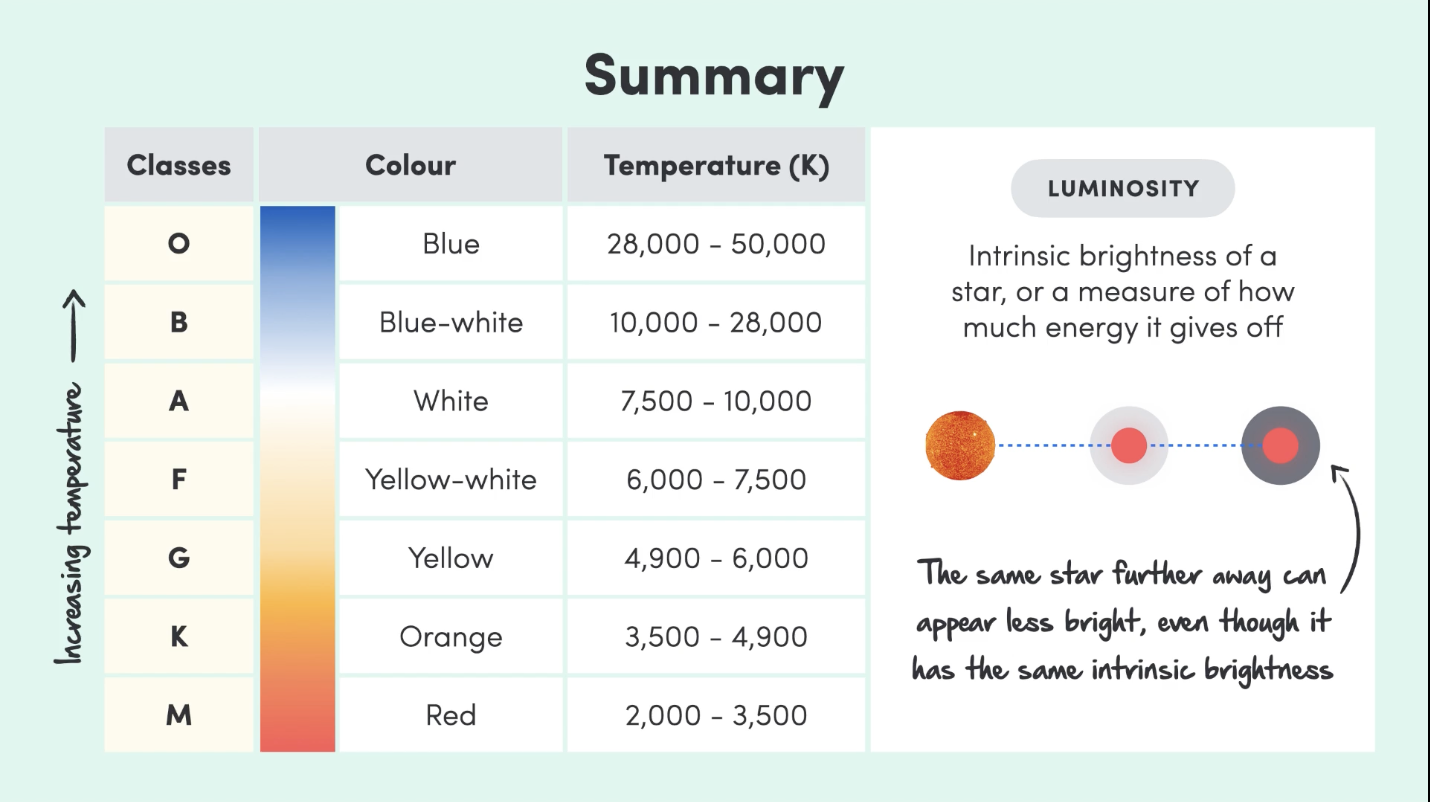
Only Boring Astronomers Find Gratitude Knowing Mass
The Hertzsprung-Russell Diagram
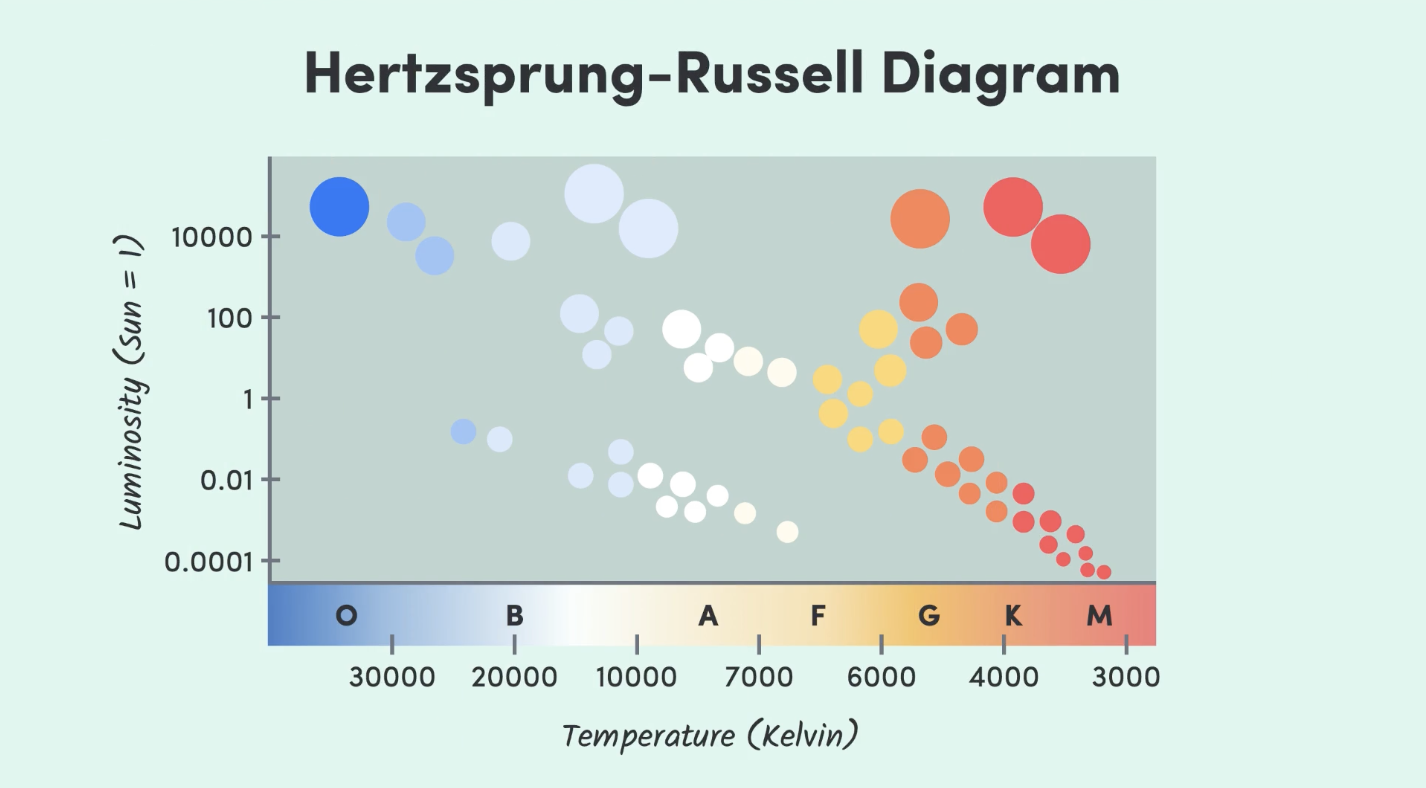
Illustrates the relationship that exists between the temperature of stars and their luminosity
Graphs the stars in the universe
Luminosity (Sun=1) on y-axis
Temperature (Kelvin) on x-axis
Key groups:
Giants: Massive but cold stars
Main sequence: Majority of stars lie and where stars start off
White dwarfs: Dim but hot stars
Telescopes
Optical Telescopes
Used to study objects in visible light
Two main types:
1. Refracting (Refractor) Telescopes
2. Reflecting Telescopes
Refracting Telescopes
Uses a lens as its objective to form an image
Also called dioptric telescopes
Earliest type of optical telescope
Invented in the Netherlands around 1608
Key figures: Hans Lippershey, Zacharias Janssen, Jacob Metius
Galileo Galilei constructed his own version in 1609
Reflecting Telescopes
Uses curved mirrors to reflect light and form an image
Invented in the 17th century as an alternative to refracting telescopes
Advantages:
Reduces chromatic aberration
Allows for very large diameter objectives
Widely used in astronomy research
Sometimes referred to as "catoptric" telescopes
Radio Telescopes
Operate in the radio frequency portion of the electromagnetic spectrum
Typically large parabolic ("dish") antennas
Used singularly or in arrays
Located far from population centers to avoid electromagnetic interference (EMI)
Placed in valleys for additional EMI shielding
STRUCTURE OF AN ATOM
the smallest part or amount of an element that can exist
Components of an atom
subatomic particles
protons
electrons
neutrons
protons and neutrons make up the nucleus
electrons orbit the nucleus
Protons:
small
positive charge
attracts anything negatively charged
small mass and charge
relative mass and charge of 1
no. of protons tell which element it is
Neutrons:
relative mass of 1
no charge
Electrons:
1/2000 of a mass of protons
relative mass of 0.0005
relative charge of -1
positive charge of the protons keep electrons from flying away
total number of electrons=total number of protons

atomic mass = protons+neutrons
THE UNIVERSE
1 movement of heat energy
explain processes underlying convection and conduction of heat energy and identify situations where waves transfer energy (eg radiation)
light and sound are convert-able forms of energy
light energy can be converted to other forms with photosynthesis and solar panels
sound energy can be transformed into electric energy via microphones
thermal energy (aka heat) is transferred from a region of high temperature to a region of cold temperature through either conduction, convection, or radiation.
conduction is mainly in solids
convection is mainly through liquids and gases
radiation can be anywhere, even in a vacuum
conduction
heat travels when fast moving particles vibrate against some more particles which vibrate against more particles, etc.
can go through objects or from one to another e.g. cooktop to saucepan
heat can travel by conduction at different speeds, depending on the type of material and state of matter
gases are poor, liquids are okay, and solids are the fastest
metals are generally better conductors than
2 waves and energy
sound and light travel as waves which transfer or propagate energy
two types of waves:
transverse waves e.g. water waves. the medium or material carrying the wave oscillates up and down perpendicular to the direction of the energy transfer. they consist of a series of crests and troughs.
longitudinal waves aka compression waves e.g. sound waves. the particles move parallel to the propagation of the wave. contains compressions and rarefactions.
wavelength = distance between two adjacent crests.
amplitude = maximum distance that each particle moves away from its resting/equilibrium position. determines loudness.
period = the time it takes from one complete wave to pass a given point (in secs)
frequency = number of complete waves that pass a point in one sec. measured in waves/second, or Hertz (Hz). determines pitch. the higher, the closer together—and vice versa.
speed = horizontal speed of a point on a wave as it propagates itself, in meters/second
also compression waves, e.g. sound waves. outcome three goes into more detail on this.
3 sound energy
it’s carried as compression waves. sound is essentially just air particles being pushed together then spread apart, bumping into each other and creating a series of compressions and rarefactions.
sound can’t travel through empty space, because there are no particles to vibrate, unlike light.
Hertz (Hz) are named after Heinrich Hertz, the German physicist who first detected radio waves in 1887.
sound waves travel faster in mediums whose particles are closer together - so solid, then water, then air
air = 343
sea water = 1533
rubber = 1600
copper = 3560
iron = 5130
diamond = 12 000
dolphins send out high frequency sound (ultrasound) to locate food and communicate.
sound moves faster in warm air due to the particles having more kinetic energy, moving quicker.
sound with frequencies higher than humans can hear is called ultrasound.
e.g. sending a sound wave through a mother’s body, some sound is reflected back from the baby, and can be translated into an image.
sonar is another word for ultrasound along the ocean floor.
a cathode ray oscilloscope converts sound energy into electrical energy, allowing it to be studied. it uses air pressure changes to detect it, and produces a graph called a waveform.
the decibel (dB) scale measures the loudness of sound. it increases by powers of 10 per 10dB; if 0dB is the quietest audible sound, 30 dB is 10^3 (1000) times that, and 40 is 10 000 times that.
any sound above 85 dB can cause hearing loss. you know it’s above this if you have to raise your voice to be heard by someone else.
4 properties of light
describe the occurrence and some applications of absorption, reflection, and refraction in everyday situations
light is an electromagnetic wave. it’s transverse.
electromagnetic waves can travel through a vacuum and travel through air at 300 000 kilometers per second.
the line used to show the path light takes are called rays.
individual light rays aren’t visible, but can be seen when the light is scattered through a material, e.g. car headlights on a foggy night, or party lights through smoke.
light reflection from curved mirrors - they can be concave (curved inwards) or convex (curved outwards). parallel rays of light are reflected to a focal point; this is outside the mirror for concave, and inside it for convex.
transparent = object on the other side visible translucent = light scattered so much object is not clearly visible opaque = can’t see it at all

light normally goes in straight lines. light can be made to bend by passing it through different transparent media, called refraction—the change in the speed of light when it moves from one substance to another.
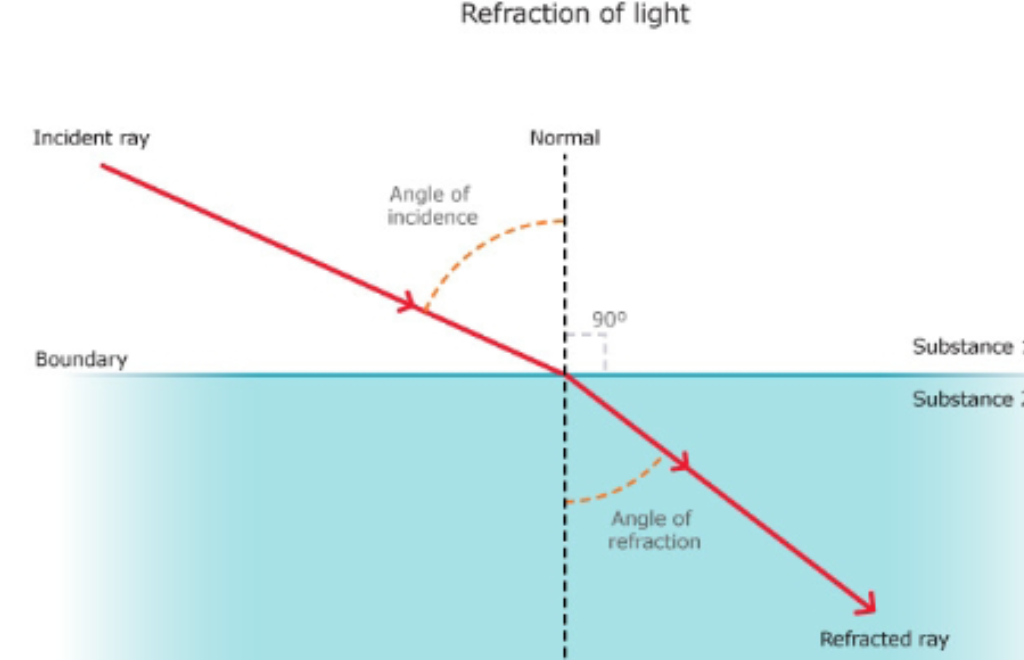
refraction:
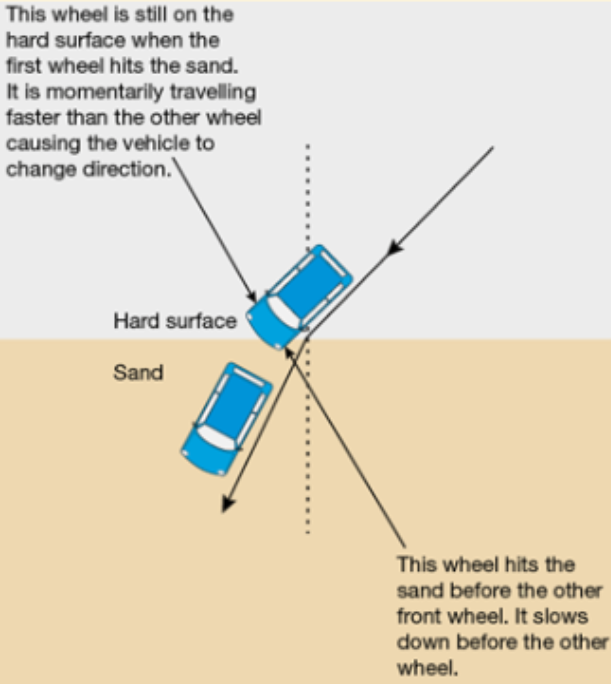
convex versus concave lenses:
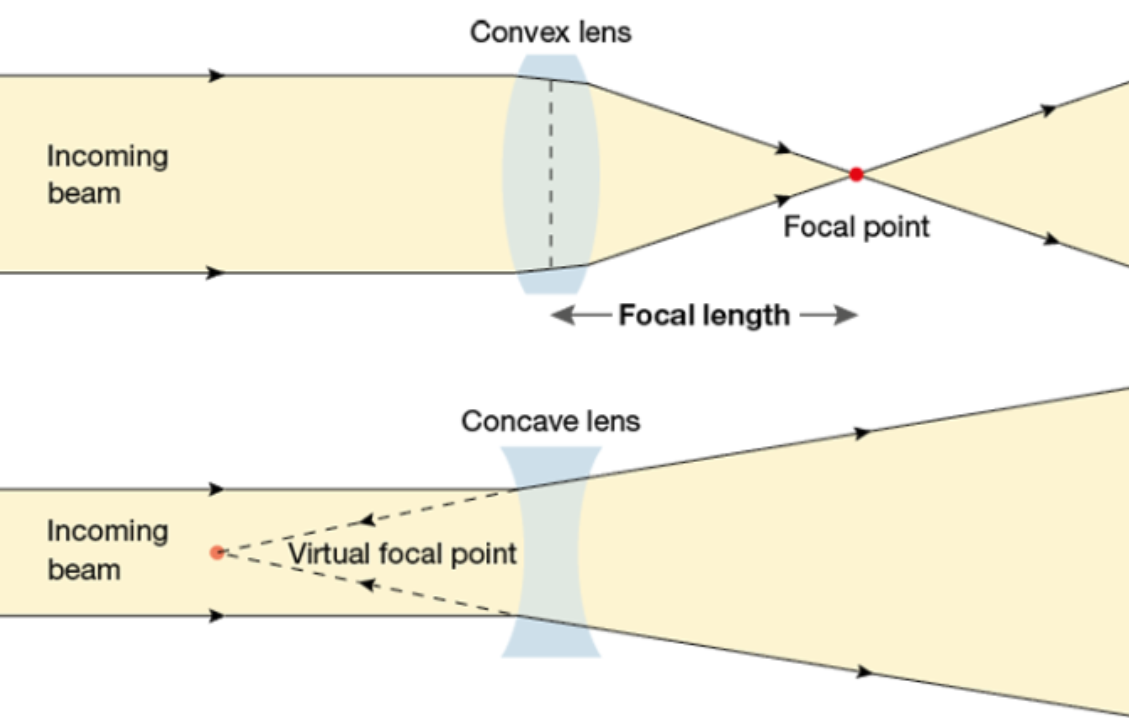
convex are called converging lenses because the light rays are refracted towards each other. concave are called diverging lenses because the rays are refracted away from each other. observed in the diagram
dispersion = separation of colours that make up white light; each one is bent out differently when entering or leaving a glass prism.
each colour is a slightly different speed, so is refracted at a slightly different angle.
the colour of an object depends on which parts of the spectrum are reflected off it towards your eyes. e.g. a red surface absorbs all colours but red.
the brain only has three colour sensitive cells—blue, green, and red. colours are just mixes of those. colours that are equal mixes of these colours are called secondary colours, i.e. yellow, magenta, cyan.
5 electromagnetic spectrum
relate the properties of different types of radiation in the electromagnetic spectrum to their uses in everyday life, including communications technology
the frequency of electromagnetic waves is the number of pulses of electric/magnetic fields generated per second.
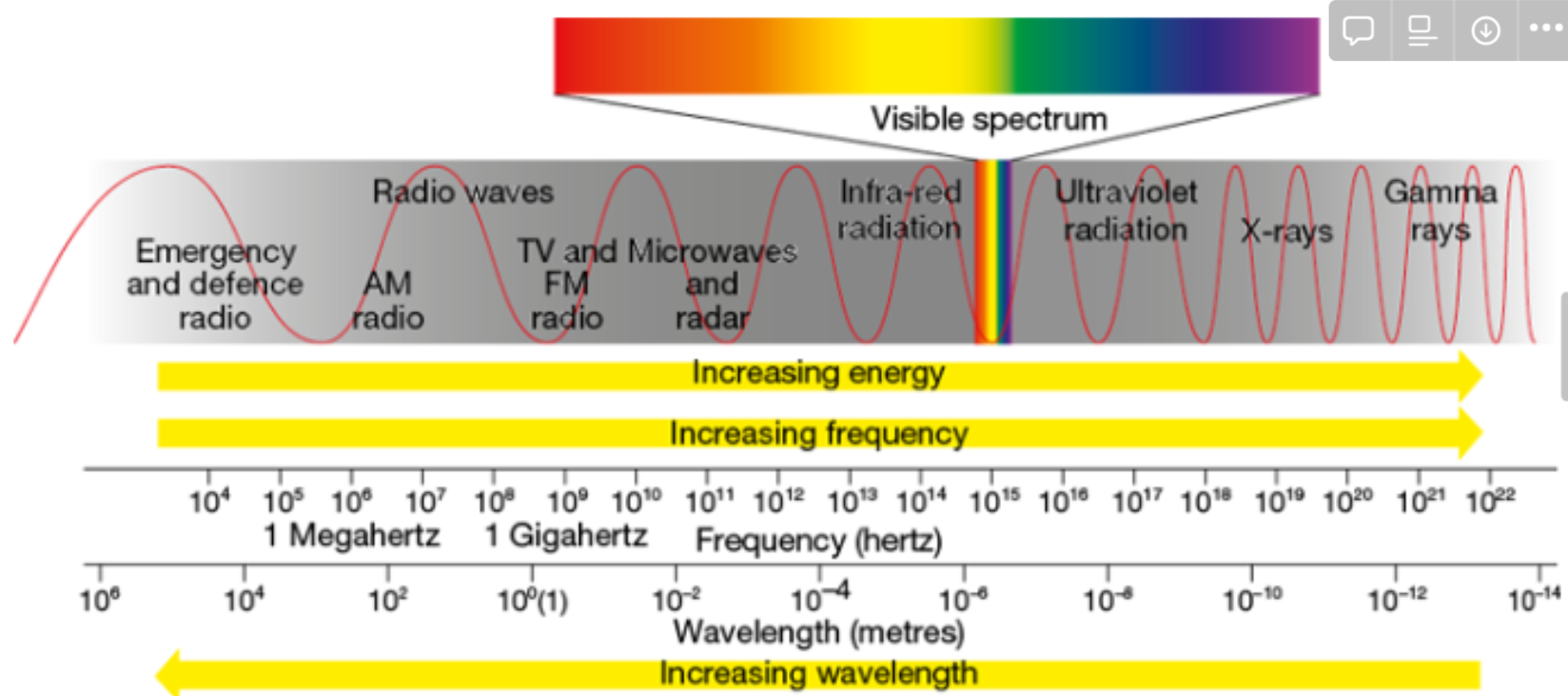
gamma waves: radioactive x-rays: medical uses ultraviolet: sunburns you visible spectrum: thank god you’re not blind! infrared: heat maps microwaves: heat your food. satellites. radio waves: transfer information. thank god for mobile data.
| A space object made of dust, gas and ice that has an elliptical orbit around the sun |
| Where we live, with a mantle, crust and core |
| The sun and all the planets, moons, asteroids and comets that orbit it |
| A space object that orbits a planet |
| A large space object that orbits a star and has no light of its own |
| A huge group of stars held together by gravity e.g. The Milky Way |
| A large hot ball of gas which produces light |
| The closest star to the Earth |
| Everything there is – all the galaxies, stars, planets and everything in between |